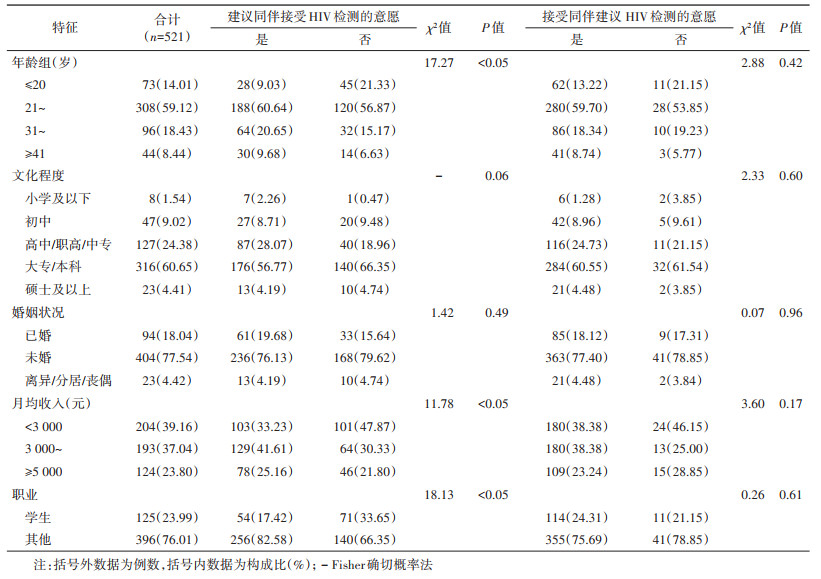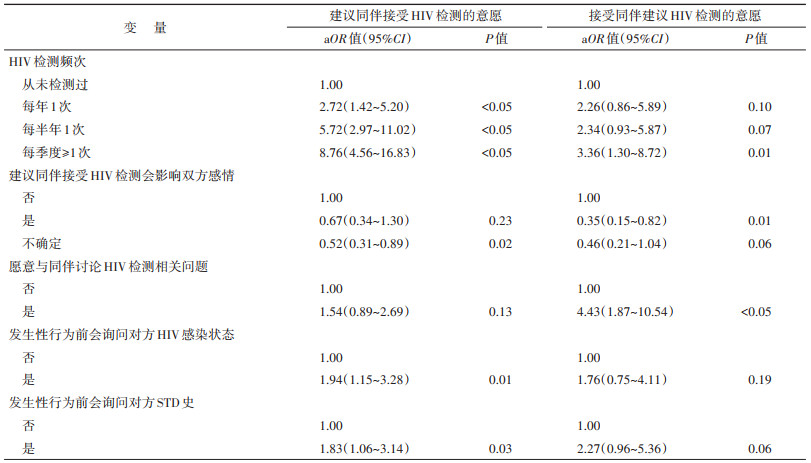文章信息
- 杨娟, 邱延超, 刘晓松, 李培龙, 梁良, 吕繁.
- Yang Juan, Qiu Yanchao, Liu Xiaosong, Li Peilong, Liang Liang, Lyu Fan
- 石家庄市男男性行为人群对同伴推动HIV检测策略的接受意愿分析
- Willingness on acceptance of peer-referral strategies for promoting HIV testing in men who have sex with men in Shijiazhuang
- 中华流行病学杂志, 2021, 42(4): 695-699
- Chinese Journal of Epidemiology, 2021, 42(4): 695-699
- http://dx.doi.org/10.3760/cma.j.cn112338-20200820-01081
-
文章历史
收稿日期: 2020-08-20
2. 石家庄市疾病预防控制中心 050011;
3. 河北省疾病预防控制中心, 石家庄 050021
2. Shijiazhuang Municipal Center for Disease Control and Prevention, Shijiazhuang 050011, China;
3. Hebei Provincial Center for Disease Control and Prevention, Shijiazhuang 050021, China
90%的HIV感染者知道自己的状况是实现联合国艾滋病规划署对全球在2030年终结艾滋病流行总体期望的阶段性里程碑之一[1]。而促进检测发现是实现该目标从而达到全球终结艾滋病流行的核心策略[2]。目前MSM的HIV感染率持续升高是我国乃至全球防治艾滋病的难点问题之一[3]。而HIV检测发现率不高是我国MSM艾滋病防治的重点问题[4]。据估算,截至2020年,我国仅有49.2%的MSM感染者被发现[5]。我国MSM接受HIV检测的比例较低是其主要原因。根据文献报道,仅有约50%的MSM曾接受过HIV检测[6-8],而近6个月以及12个月曾接受HIV检测的比例分别仅30%[9]和38%[8]。究其原因,针对性少数人群和HIV感染者的相关歧视是阻碍MSM接受HIV检测的主要因素之一[10]。目前我国扩大HIV检测主要依赖提供HIV检测的卫生服务机构以及MSM社会组织,但由于MSM的隐蔽性和难以接触性,当前的干预方式仍然存在一定的局限性。近年来,同伴推动干预项目在国际上逐渐应用于促进HIV检测,并获得了较好的效果[11-13]。但该措施在我国并未大范围应用于促进MSM的HIV检测方面。本研究主要目的是了解调查地区MSM对同伴推动HIV检测策略的接受意愿及其相关因素,为该策略的具体实施和优化提供一定参考。
对象与方法1. 调查对象:纳入标准:①≥18岁男性;②最近12个月发生男男性行为;③最近3个月在石家庄市生活;④意识清楚,可独立完成问卷。2. 调查方法与内容:采用自行设计的调查问卷,登录金数据企业版(https://im.jinshuju.com/users/sign_in)开展线上匿名调查。2018年8-9月,通过石家庄市MSM自建的微信群和QQ群、2家MSM社会组织工作室,分享线上问卷二维码,方便抽样方式招募544名MSM作为调查对象。调查内容包括社会人口学、行为学、HIV检测频次、对同伴HIV检测相关态度。
3. 相关定义:
(1)同伴推动HIV检测策略的接受意愿分为两类:①建议同伴接受HIV检测的意愿;②接受同伴建议HIV检测的意愿。通过MSM自身力量,发现并促进更多难以接触的MSM接受HIV检测,以提高HIV检测发现率。参照同伴推动抽样的方式[13],对MSM宣传和介绍,征求其同意后,向其发放一定数量的招募券,讲解使用及奖励措施,使其作为种子积极招募合适的同伴接受HIV检测。
(2)婚姻状况:①未婚:有男/女朋友,或者国内未婚但国外已婚者;②已婚:存在形式婚姻,表面上由一男一女组成正常家庭,实际上夫妻双方在生理和人格上各自保持独立[14]。
4. 统计学分析:使用SAS 9.4软件进行统计学分析。采用χ2检验分析人口学特征及其与MSM同伴推动HIV检测策略接受意愿的关系。采用单因素、多因素logistic回归模型分析MSM同伴推动HIV检测策略接受意愿相关因素。检验水准α=0.05,双侧检验。
结果1. 基本人口学特征:招募544名MSM中,完成有效问卷521份。调查对象≤30岁占73.13%,大专/本科及以上文化程度占65.06%,未婚者占77.54%,月均收入 < 5 000元占76.2%,其他职业占76.01%。建议同伴接受HIV检测的意愿占59.50%(310/521),接受同伴建议HIV检测的意愿占90.02%(469/521)。不同年龄组、月均收入水平、职业的MSM,建议同伴接受HIV检测的意愿略有差异,但接受同伴建议HIV检测的意愿的差异无统计学意义;不同文化程度、婚姻状况的MSM,在同伴推动HIV检测策略的接受意愿的2个方面差异均无统计学意义。见表 1。
2. 建议同伴接受HIV检测的意愿相关因素分析:多因素logistic回归模型分析结果显示,正相关因素包括HIV检测频次分别为每年1次(aOR=2.72,95%CI:1.42~5.20)、每半年1次(aOR=5.72,95%CI:2.97~11.02)与每季度≥1次(aOR=8.76,95%CI:4.56~16.83)、发生性行为前询问对方HIV感染状态(aOR=1.94,95%CI:1.15~3.28)和STD史(aOR=1.83,95%CI:1.06~3.14),而建议同伴接受HIV检测会影响双方感情持不确定态度是负相关因素(aOR=0.52,95%CI:0.31~0.89)。见表 2。
3. 接受同伴建议HIV检测的意愿相关因素分析:多因素logistic回归模型分析结果显示,正相关因素包括HIV检测频次为每季度≥1次(aOR=3.36,95%CI:1.30~8.72)、与同伴讨论HIV检测相关问题(aOR=4.43,95%CI:1.87~10.54),而认为建议同伴接受HIV检测会影响双方感情是负相关因素(aOR=0.35,95%CI:0.15~0.82)。见表 2。
讨论我国MSM近年来HIV感染率上升趋势明显[15],但是其HIV检测的意愿和检测比例相对较低[16],同伴推动HIV检测是一项重要策略。本研究发现,石家庄市MSM建议同伴接受HIV检测的意愿、接受同伴建议HIV检测的意愿分别占59.50%和90.02%,同伴推动HIV检测策略这两个方面存在不同特征和心理状态,要充分考虑MSM亚文化、行为学及心理等因素,提高其主动建议同伴接受HIV检测的意愿。
有研究表明,每季度1次的HIV检测频次,可提高HIV感染者新发现率[17]。本研究发现,不同的HIV检测频次,对于MSM建议同伴接受HIV检测的意愿的影响较为明显,最近12个月检测频次较高者,更愿意建议同伴接受HIV检测。在MSM干预工作中,注意寻找HIV检测频次较高的MSM,开展动员和培训,让其引导更多的MSM接受HIV检测。
本研究发现,认为建议同伴接受HIV检测会影响双方感情的MSM,接受同伴建议HIV检测的意愿较低,但是在建议同伴接受HIV检测的意愿方面无明显影响。Ong等[18]研究发现,MSM在接受同伴建议HIV检测时,特别是在双方沟通不畅时,经常会感受到压力,易产生愤怒和羞辱等不愉快情绪。本研究发现,愿意与同伴讨论HIV检测相关问题的MSM,更愿意接受同伴HIV检测建议,说明同伴推动HIV检测的策略,提高双方沟通技巧,可提高MSM接受同伴建议HIV检测的意愿。
国内8个城市相关研究发现,曾使用过HIV自检试剂的MSM,更愿意在发生性行为前询问对方HIV感染状态[19],说明其自我保护意识较强,而且更愿意建议同伴接受HIV检测,但接受同伴建议HIV检测的意愿不明显。MSM在发生性行为前,如果主动询问对方敏感问题,更有可能在双方性关系中占据主导地位,并引导同伴接受HIV检测。Ricks等[20]针对美国南部MSM性伴关系相关研究发现,发生性行为时在使用安全套上更有话语权的MSM,更容易有自我保护的行为。在MSM扩大HIV检测工作中,增强其自我保护意识,有利于其主动建议同伴接受HIV检测。
本研究存在不足。问卷调查仅收集MSM对同伴推动HIV检测策略的接受意愿情况,未深入研究MSM在同伴推动HIV检测活动的实际情况。
综上所述,提高MSM主动建议同伴接受HIV检测的意愿,增强自我保护意识和双方平等交流及沟通的技巧,是MSM同伴推动HIV检测策略成功的关键。
利益冲突 所有作者均声明不存在利益冲突
志谢 感谢石家庄同行工作组、河北向日葵工作组的支持和帮助
| [1] |
The Joint United Nations Programme on HIV/AIDS (UNAIDS). 90-90-90: An ambitious treatment target to help end the AIDS epidemic[EB/OL]. (2017-01-01)[2020-07-01]. https://www.unaids.org/en/resources/documents/2017/90-90-90.
|
| [2] |
Easterbrook P, Johnson C, Figueroa C, et al. HIV and hepatitis testing: global progress, challenges, and future directions[J]. AIDS Rev, 2016, 18(1): 3-14. |
| [3] |
Dong MJ, Peng B, Liu ZF, et al. The prevalence of HIV among MSM in China: a large-scale systematic analysis[J]. BMC Infect Dis, 2019, 19: 1000. DOI:10.1186/s12879-019-4559-1 |
| [4] |
Tang SY, Tang WM, Meyers K, et al. HIV epidemiology and responses among men who have sex with men and transgender individuals in China: a scoping review[J]. BMC Infect Dis, 2016, 16: 588. DOI:10.1186/s12879-016-1904-5 |
| [5] |
Zhuang X, Peng P, Sun HM, et al. Scaling up human immunodeficiency virus screening and antiretroviral therapy among men who have sex with men to achieve the 90-90-90 targets in China[J]. Sex Transm Dis, 2018, 45(5): 343-349. DOI:10.1097/OLQ.0000000000000744 |
| [6] |
Huang ZJ, He N, Nehl EJ, et al. Social network and other correlates of HIV testing: findings from male sex workers and other MSM in Shanghai, China[J]. AIDS Behav, 2012, 16(4): 858-871. DOI:10.1007/s10461-011-0119-4 |
| [7] |
Zhang L, Xiao Y, Lu RR, et al. Predictors of HIV testing among men who have sex with men in a large Chinese city[J]. Sex Transm Dis, 2013, 40(3): 235-240. DOI:10.1097/OLQ.0b013e31827ca6b9 |
| [8] |
Zou HC, Hu N, Xin QQ, et al. HIV testing among men who have sex with men in China: a systematic review and Meta-analysis[J]. AIDS Behav, 2012, 16(7): 1717-1728. DOI:10.1007/s10461-012-0225-y |
| [9] |
Xu WJ, Zheng Y, Kaufman MR. Predictors of recent HIV testing among Chinese men who have sex with men: a barrier perspective[J]. AIDS Patient Care STDS, 2018, 32(10): 408-417. DOI:10.1089/apc.2018.0061 |
| [10] |
Wei CY, Yan HJ, Yang CK, et al. Accessing HIV testing and treatment among men who have sex with men in China: a qualitative study[J]. AIDS Care, 2014, 26(3): 372-378. DOI:10.1080/09540121.2013.824538 |
| [11] |
Mericle AA, Hemberg J, Stall R, et al. Pathways to Recovery: Recovery housing models for men who have sex with men (MSM)[J]. Addict Res Theory, 2019, 27(5): 373-382. DOI:10.1080/16066359.2018.1538409 |
| [12] |
Glasman LR, Dickson-Gomez J, Lechuga J, et al. Using peer-referral chains with incentives to promote HIV testing and identify undiagnosed HIV infections among crack users in San Salvador[J]. AIDS Behav, 2016, 20(6): 1236-1243. DOI:10.1007/s10461-015-1267-8 |
| [13] |
Ong'wen P, Samba BO, Moghadassi M, et al. Chain peer referral approach for HIV testing among adolescents in Kisumu county, Kenya[J]. AIDS Behav, 2020, 24(2): 484-490. DOI:10.1007/s10461-019-02560-2 |
| [14] |
张晨明. 女同性恋者在形式婚姻中的角色认知与关联因素分析[J]. 中国性科学, 2019, 28(10): 145-148. Zhang CM. The role cognition and related factors of lesbians in marriage of convenience[J]. Chin J Human Sexual, 2019, 28(10): 145-148. DOI:10.3969/j.issn.1672-1993.2019.10.040 |
| [15] |
李东民, 葛琳, 王岚, 等. 中国2010-2013年男男性行为人群艾滋病及相关行为变化趋势分析[J]. 中华流行病学杂志, 2014, 33(5): 542-546. Li DM, Ge L, Wang L, et al. Trend on HIV prevalence and risk behaviors among men who have sex with men in China from 2010 to 2013[J]. Chin J Epidemiol, 2014, 33(5): 542-546. DOI:10.3760/cma.j.issn.0254-6450.2014.05.016 |
| [16] |
孟晓军, 王旭雯, 顾静, 等. 基于结构方程模型的男男性行为人群HIV检测行为影响因素研究[J]. 中华流行病学杂志, 2020, 41(5): 758-763. Meng XJ, Wang XW, Gu J, et al. Study on HIV testing behavior among men who have sex with men based on structural equation model[J]. Chin J Epidemiol, 2020, 41(5): 758-763. DOI:10.3760/cma.j.cn112338-20190702-00485 |
| [17] |
Furegato M, Mitchell H, Ogaz D, et al. The role of frequent HIV testing in diagnosing HIV in men who have sex with men[J]. HIV Med, 2018, 19(2): 118-122. DOI:10.1111/hiv.12558 |
| [18] |
Ong JJ, Wu D, Huang WT, et al. Pressured HIV testing "in the name of love": a mixed methods analysis of pressured HIV testing among men who have sex with men in China[J]. J Int AIDS Soc, 2018, 21(3): e25098. DOI:10.1002/jia2.25098 |
| [19] |
Tang WM, Liu CC, Cao BL, et al. Receiving HIV serostatus disclosure from partners before sex: results from an online survey of Chinese Men who have sex with men[J]. AIDS Behav, 2018, 22(12): 3826-3835. DOI:10.1007/s10461-018-2062-0 |
| [20] |
Ricks JM, Crosby RA, Mena L. Relationship power and HIV risk among young Black men who have sex with men in the Southern United States[J]. Sex Health, 2018, 15(4): 292-297. DOI:10.1071/SH17084 |
 2021, Vol. 42
2021, Vol. 42




